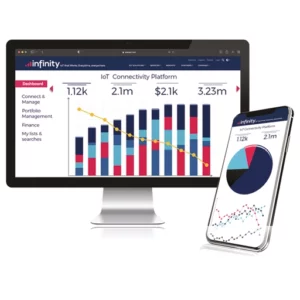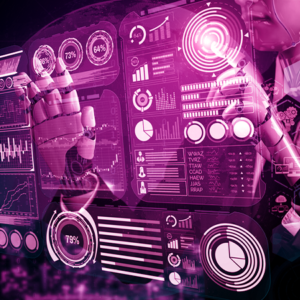Blogs
20 December 2022
Reading Time: 6 mins
Blogs
20 December 2022
Reading Time: 6 mins

Istvan Lajtos
Head of Product Management
LinkedInAs the lines between physical and digital environments blur, IoT data becomes ever more critical in creating the data products and digital twins that deliver real value and may – in time – enable metaverse environments. IoT connectivity is critical to ensuring the reliable, timely delivery of data for processing. Eseye’s Infinity IoT Platform™ provides that connectivity and the data to support IoT intelligence operations.
IoT data is key to understanding what has happened (descriptive and diagnostic analytics), what is happening (real-time analytics and stream processing), what is going to happen (predictive analytics) and what is decided should happen (prescriptive analytics).
Many businesses use powerful business intelligence (BI) and artificial intelligence (AI) tools to perform these different types of analytics on their IoT data. For example, EDF Energy uses AI to perform character recognition to pick out and process the figures on meter readings reported by energy customers; they then use machine learning to perform pattern recognition to spot trends in usage data collection. While in retail, Ocado combines Google’s open-source TensorFlow machine learning tools and cloud APIs to support internal AI projects. This improves workflow processes by automating customer-service-related communications.

All devices managed by Infinity connect to and send data through Infinity’s private network. With this view of all device connections and communications, Infinity collects vast amounts of connectivity data for each device.
Infinity uses this data to monitor and report on devices and estates. It uses analytics and AI to process the data in conjunction with control plane data from the networks to identify issues and optimise connectivity for all devices.
The data that devices send to the cloud is the prime source for a customer’s analytics operations. But this data can be complemented with Infinity’s connectivity data to provide additional context and insights.
Identifying patterns of behaviour in device connectivity can provide key insights into estate performance and how users and devices operate.
Pattern matching can highlight anomalies. These could indicate issues with devices or networks that are affecting connectivity. Or there might be fraudulent behaviour if devices move location unexpectedly or suddenly use significantly more data.
Device usage and trends can highlight variations between different groups of devices, for example by area or type of user or service. These insights could feed into continuous improvement programmes or decision making for future developments, such as planning expansion within a country or into other countries.
Infinity connectivity data is stored in a data lake. APIs can seamlessly integrate your data into your own or partner systems. This gives you the flexibility to add connectivity data into your own analytics and AI tools.
Infinity provides a set of RESTful APIs to access your device and estate data, and a PUSH API to stream near-real-time data into your systems.
You also have access to an extensive set of pre-configured reports and can set up alerts based on your own requirements.
Infinity analytics tools generate a variety of reports to help you manage your estate, devices and business. You can configure alerts to notify you of unexpected or significant events.
High level reports to manage your estate
With deployments of many thousands of devices, it’s crucial to see high level views of connectivity performance and status for the whole or a subset of the estate.
Some of these reports include:

Device reports provide the basis for diagnostics and troubleshooting. Some of these reports include:
Infinity management reports include:
You need to know when unexpected and significant events occur in your estate.
For example, you might need to investigate devices that transmit much more or much less data than expected. Higher than planned data usage could be running up huge charges. Low – or no – data usage could signify device or connectivity problems.
A SIM that’s moved into a different device could indicate that the SIM has been stolen.
Infinity raises alert notifications if your devices are behaving unexpectedly. It can suspend SIMs if there’s a risk of foul play or issues that need investigating.
You can configure conditions for triggering device alerts and suspensions:
You can define alert profiles for individual or groups of devices.
You can also set up multiple alerting levels. For example:
IoT, Big Data and AI are key to unlocking the potential of digital transformations.
Collecting and processing machine and sensor data isn’t new. But the number of devices and the volumes of data for processing are expanding dramatically. Traditional tools aren’t up to the job – we need new ways to approach this challenge.
Safety or business critical use cases, for example, need high-speed, reliable connectivity and may need AI processing at the edge. For massive deployments, higher latency at lower cost might be acceptable.
New, distributed architectures address these different requirements. They can spread the data and processing across devices, sites and a multi-function edge by using technologies such as microservices, containerization, edge AI and hybrid clouds.
The current approach is to measure how systems perform and use the results to optimise and redistribute processing power.
A better approach is to use models to simulate distributed systems, simultaneously optimising across requirements and constraints, such as service levels, performance, security, cost, power and energy consumption.
An architect can map application and data building blocks to different resource types and use models to examine different variables. Model simulations can analyse the impact of redesigning the application building blocks and determining the impact on compute, storage, and connectivity.
Eseye engineers can use Infinity Big Data to design and train the machine learning (ML) models that form the connectivity element of the simulations.
The data – collected across a huge range and size of deployments over many years – enables the engineers to create models that can optimise connectivity simultaneously across multiple constraints. These include requirements for availability, reliability, bandwidth, latency, cost, power and security.

The Infinity IoT Platform™ is designed to evolve and adapt to emerging trends in IoT, such as the increasing use of BI, AI and ML to analyse and act on data.
As your deployments scale and your business requirements change, you can be sure that Infinity can meet your new or changing connectivity and analytics needs. The Infinity SDK and APIs enable seamless integrations with your own and partner systems.
You have the control and flexibility to manage your devices and drive value from their data in the most efficient, cost-effective, and powerful way for your business.

Istvan Lajtos
Head of Product Management
LinkedInIstvan’s telecommunications career spans more than twenty years in a variety of roles, including product management, technical account management and marketing. Istvan leads on product management with expertise in communication technology strategy development, smart city technology and IoT, 4G to 5G mobile network evolution to secure content delivery.